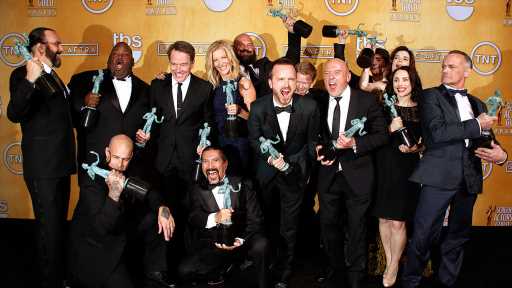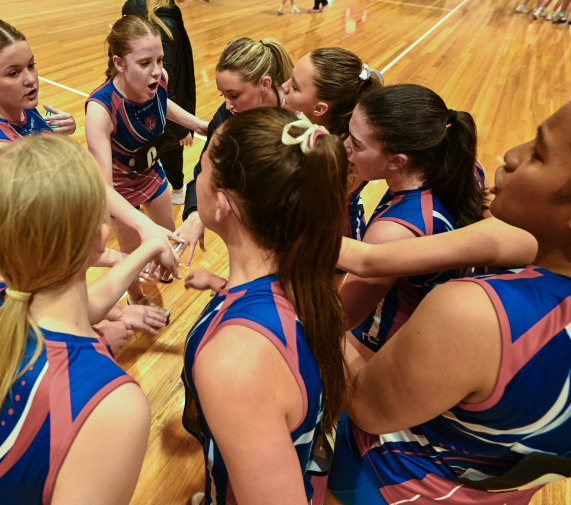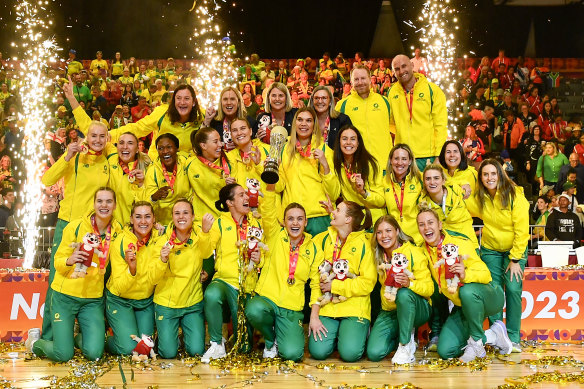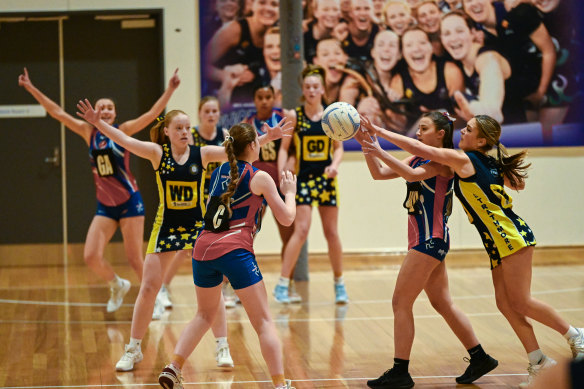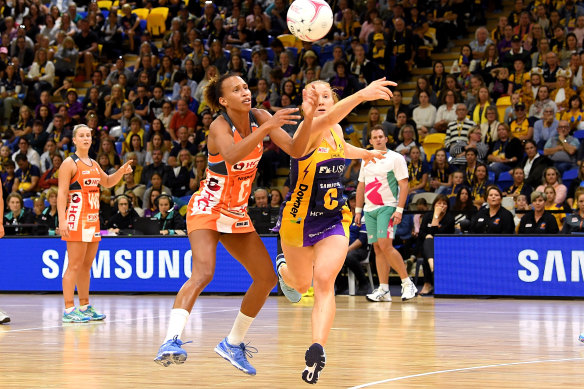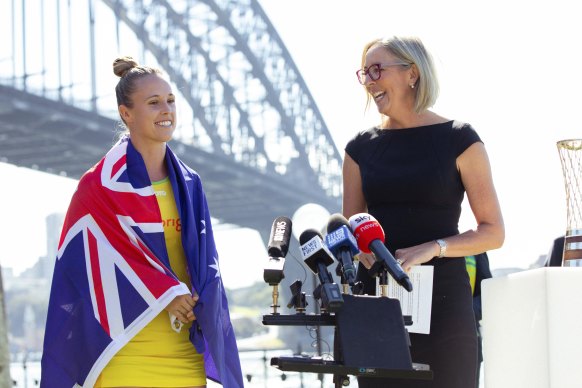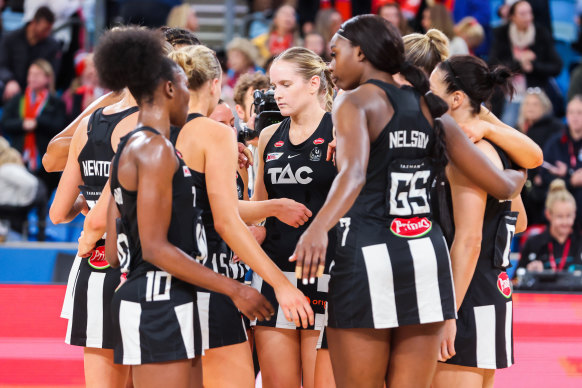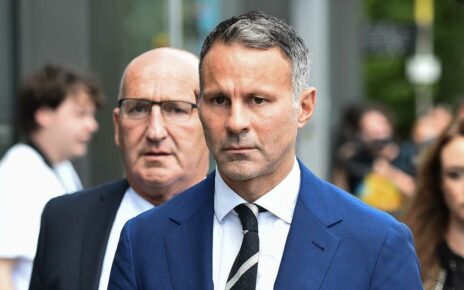By Carla Jaeger
Westside Saints netballers in a huddle. Netball is Australia’s biggest participation sport for girls and women.Credit: Joe Armao
Save articles for later
Add articles to your saved list and come back to them any time.
If you want to know how popular netball is in Australia, the Parkville netball courts on a Thursday afternoon will give you a pretty good idea.
On this particular night, the Westside Saints under-15s are taking on Strathmore; and the stadium is filled with an orchestra of whistles, shoes squeaking on the acrylic court, and echoing shouts from parents on the sidelines.
The scene, replicated at local courts across the country, features just a fraction of netball’s one million or so participants. Of those, about 900,000 are girls and women – earning netball the status of Australia’s most popular female team sport.
The elite level of the sport is just as successful. This month, the Diamonds won their 12th Netball World Cup title, completing a clean sweep of the major trophies on offer in the current four-year cycle.
The Diamonds won the World Cup for the 12th time.Credit: Getty Images
But these two images don’t tell the full story. Somewhere between the 15-year-old netballers on those buzzing local courts and the triumphant, athletic women dominating on the world stage, something is broken in Australian netball.
In the past 18 months, internal stoushes and financial crises have eclipsed netball’s successes.
Last year, the sport was reported to have $11 million of debt and losses. Then there was the logo dispute that led to Hancock Prospecting withdrawing from its $15 million sponsorship deal, which put netball at the centre of the culture wars, and a debate over the rights of athletes to have a say in the corporate decisions of their employers. This year’s Super Netball season was dominated by the news that one of the biggest sporting clubs in the land, the Collingwood Football Club, was terminating its netball program, which had struggled for success and commercial cut-through during its seven years in the league. All this against the backdrop of a simmering pay dispute between Netball Australia and its players.
Most recently, a secret report authored by former NRL boss David Gallop, revealed by this masthead, cast serious doubts on the financial viability of the Super Netball league, which is considered the premier domestic netball league in the world and produced the champion players who held aloft the World Cup in South Africa a couple of weeks earlier.
Westside Saints and Strathmore in action.Credit: Joe Armao
The report found the league was losing millions of dollars – it was on track to lose $7.5 million in the next three years – and was under siege from other professional or semi-professional women’s sporting leagues.
“SSN [Super Netball] is competing in a highly competitive market with increasing numbers of professional women’s sports leagues fighting for fans, sponsorship and broadcast rights,” the Gallop report said.
While soccer’s A-Leagues (men’s and women’s) are among the leagues battling for eyeballs in this newly crowded market, it was lost on no one that while netball was facing an existential crisis, the nation was falling in love with the Matildas.
This masthead has interviewed 13 people involved in netball, including past and present players, administrators and broadcast experts. Most requested anonymity because they were discussing confidential or commercially sensitive issues, or because they did not want to damage already strained relationships.
The interviews paint a picture of mounting tension within the sport, a perceived lack of action to address the issues that were raised in the Super Netball report, and an increasingly adversarial relationship between Netball Australia and its players. Most of all, the sources feared netball had missed a golden opportunity to capitalise on the sport’s enormous potential.
As one ex-board member said: “The sport is fighting for its life. Stop fighting with each other, lift your eyes and look over the fence.”
Left behind
Maddy McAuliffe was 22 when she made her debut for the Sunshine Coast Lightning in 2017 for the first Super Netball season.
“It was a buzz,” McAuliffe recalled, noting a feeling among the playing group that they were entering a new era for the sport. The players were now earning enough to make a living, and the league would, if executed correctly, drive netball into a more commercial direction.
Those who developed the new domestic league, which replaced the trans-Tasman ANZ Championship, had set out to reimagine netball. They planned to attract external investment – for example, Lightning are owned by Melbourne Storm – and drive growth of the sport from the top down.
“There was this real moment of, ‘is this the turning point?’,” said McAuliffe, who stepped away from netball in 2021 to focus on her legal career. “[But] I think it’s probably that it’s just sat in that state for a while.”
While netball stagnated, other sports were busy catching up. Bankrolled by their mega-rich men’s competitions, AFLW appeared on the scene the same year as Super Netball, cricket pushed in with its successful Women’s Big Bash League in 2015, and in 2018 the NRLW arrived.
Maddy McAuliffe in action for Sunshine Coast Lightning.Credit: Getty Images
“Netball has existed in a silo for 10, 15 years. Now we’re operating in this new competitive landscape, it’s act now or be left behind,” McAuliffe said.
The fear is that netball, while maintaining its high participation rates at the grassroots level, will become a talent pipeline for these other sports.
To address the sport’s burgeoning issues, netball started to look introspectively. The State of the Game review, led by netball great Liz Ellis, was published in 2020, providing eight recommendations.
While some of the report’s recommendations have been implemented – such as developing an aligned vision between the member organisations – many are still in the works, operating on a “business as usual” basis.
“SSN must be the commercial jewel in Netball Australia’s crown,” the report urged. It noted its current structure was “not optimised for commercial growth”.
Two years later, in 2022, the Gallop report made the same assessment.
Netball Australia boss Kelly Ryan is adamant the league can still become the sport’s “crown jewel”, but said the organisation would not change the model while under the current broadcast deal.
This has been maddening for some, who feel that while there have been two reports handed down providing solutions to the problem, no substantial effort has been made.
“I have concerns around the strategy that is currently around Super Netball. I’d love to see a strategy for growth, a strategy for long-term return on investment, what’s going to happen over the next two, five, 10 years,” said Ellis, Australia’s most capped international netballer.
Collingwood and their players unloaded on Netball Australia, pointing to a lack of direction and financial viability for Super Netball. “There is untenable dysfunction and disharmony between administration and the playing group. There is also no confidence in the strategic direction of Netball Australia,” the players said in a statement at the time.
But not everyone is worried. Sports Entertainment Network, the media company run by journalist and businessman Craig Hutchison, will replace the Magpies in the league and SEN’s Richard Simkiss described netball’s commercial potential as an “untapped opportunity”.
Simkiss also dismissed any need to consider the reasons that Collingwood had outlined for their departure, claiming the two organisations had vastly different circumstances.
“We don’t see that at all as a fresh set of eyes coming in … We see amazing, strong foundations and great metrics,” Simkiss said, pointing to the sport’s high grassroots numbers.
The SEN executive would not disclose how the sporting media conglomerate planned to commercialise their team, but said: “We’re brand rich and have hundreds of active relationships all over the country. They want to connect with madly passionate fans.”
How to make money
Netball Australia announced a profit of $300,000 last financial year, but a $4.2 million debt remains.
While netball received a $9.4 million boost from the Australian Institute of Sport, it’s not known if that funding will continue beyond 2026 as questions swirl around the future viability of the Commonwealth Games.
The sport will receive a share of the newly announced $200 million girls’ sports fund, but it’s unclear where that money will be spent.
“What I don’t understand is what strategy there is to make Super Netball profitable. And to me, that’s something that’s really missing,” one netball figure said.
“The sport is fighting for its life. Stop fighting with each other, lift your eyes and look over the fence.”
Former Diamonds coach Lisa Alexander believes private investment is the only solution, a belief echoed by several sources.
“Netball Australia is trying to be lots of things to lots of people … Maybe it’s time for them to think about perhaps going down the privatised approach to the league itself,” she said.
But there are fears within the sport that a private equity takeover would irrevocably harm netball, and even those who support a buyout of the league believe a partner that understands the sport’s vision is integral.
Netball great Liz Ellis (right) with Diamonds player Paige Hadley.Credit: Dominic Lorrimer
Asked why the sport was not pursuing private equity investment, Ryan said: “[Some people may think that] capital injections are free money, but they’re not, and serious consideration is required when making these decisions.”
Two sources argued that Netball Australia had not properly leveraged opportunities within its five-year, $7 million-a-year broadcast deal with Foxtel.
Netball Australia inked the deal in 2021, moving the majority of the sport behind a paywall, and marking the end of its commercial relationship with Nine, owner of this masthead.
Part of the contract means if netball decided to develop other competitions – such as a global championship or all-star comp – Foxtel would fund all the TV production. The contract also allows for the addition of two more teams to Super Netball, increasing the league’s matches from four to five a week.
“All of that is new revenue you could bring in overnight,” one figure said.
But because of the costs Netball Australia would incur (two years ago Netball Australia was paying around $760,000 to each of the eight teams within the league to cover associated costs, a number which may have since increased), doubt has been cast about whether this is a viable option.
While the sport may not be able to afford a new team – let alone two – some believe Netball Australia could go to market with those licences.
Adding to the laundry list of worries is a fear that when negotiations start for the next broadcast deal, the opportunity to leverage more money will be lost, and Super Netball’s “commercial jewel” potential will fall further into obscurity.
So, how can netball convert its great strength – its participation base – into an elite competition that can not only sustain itself but generate revenue to be reinvested in the sport?
Several sources said repairing the relationship with its players would be a good place to start.
“Netball players are by and large, intelligent, capable women. They constantly get pushed to the curb by people who can’t be bothered understanding what they think,” one senior netball figure said.
Collingwood will no longer play in the Super Netball league.Credit: Getty Images
Ryan rejected this suggestion, insofar as it was directed at her. She said she “absolutely” considered the players as partners, and took their views seriously.
“The ANPA [the player union] wants things, the clubs wants things. We’re trying to forge an agreement that suits everyone,” she said of collective bargaining talks. A one-year extension to the existing deal was agreed after Netball Australia initially refused to announce the World Cup squad until an agreement was signed, a move Alexander described at the time as “outrageous behaviour”.
The trouble within
Adding to this dysfunction, say some, is a disconnect between the objectives of the state federations and national body.
The federated model of the sport means the state bodies have voting rights in the national body, and, in addition, each runs a team in Super Netball.
“The federated system works really well for the states to deliver grassroots netball,” a source who played a significant role at the national body said.
However, there is a belief this dual role of the state bodies can get in the way of netball’s overall vision.
“It’s not that the member organisations shouldn’t be involved, it’s that they shouldn’t own the clubs,” one source said.
“The relationships with the member organisations – because of the political imbalance – it means that it’s managed more on a sort of friendship group basis, rather than you know, just good old hard economic rationalisation.”
This belief is not shared by Netball Queensland boss Kate Davies.
“There is a strength to netball’s federated model that allows us to connect and learn from the grassroots member associations right through to the other states and Netball Australia,” she said. “While we don’t shy away from robust discussions that come with the challenges of sports administration, we are also motivated to find solutions that are win-win for all involved.”
Netball Victoria said the Melbourne Vixens, the team owned by the state body, encouraged grassroots participation – the funds of which are currently financing the league.
“They play a key role in attracting new audiences to netball and growing the game commercially, including drawing viewers, crowds and partners to our game,” Netball Victoria said in a statement.
The other state bodies did not respond to requests for comment.
Governance talk means little to the teenagers on the court in Parkville, but it might be the key to netball holding the football codes and cricket at bay.
The 53-page State of the Game review pre-dates Ryan’s tenure and highlights the scale of the problem she was brought in to fix. The 2020 review referenced the need to end the “pettiness and fiefdoms” in the game. Three years on, one source recalls a particular sentence.
“The greatest threat to Australian netball comes from within.”
With Marnie Vinall
News, results and expert analysis from the weekend of sport sent every Monday. Sign up for our Sport newsletter.
Most Viewed in Sport
Source: Read Full Article
